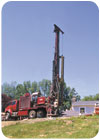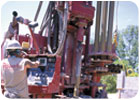
Edward Powell Pump & Well Drilling Inc. is making a profitable run at the geothermal drilling market.
The water well drilling and pump business has been mighty good to Edward Powell Pump & Well Drilling Inc. for more than 40 years. The company is a family-owned business with family members managing it. Founded by Edward Powell, who has since retired, the company presently is under the leadership of his son David, president.
The younger Powell, a graduate from Penn State University, thinks like a businessman who happens to be in the water well business. He portrays the company as a full-service firm, where the homeowner and contractor can have a water well drilled, have a pump and tank installed, and, if necessary, have a water conditioner installed. Other services offered by Powell include full service with 24/7 emergency calls available, well inspections, water sampling and annual maintenance service contracts. Currently, the company has more than 800 service contracts that also include water sampling, complete equipment repairs and preventive maintenance.
Location, Location, Location
Powell’s headquarters is located in Aston, a relatively densely populated area in southeastern Pennsylvania. Aston is about 25 miles west of Philadelphia, where most homes are owned by the middleclass to upper middleclass. Yet, there still are plenty of rural areas nearby with active home-building always underway. With a mix of new home-building activities and the well-established homes all within a servicing distance from Aston, it plays well for Powell in having a prosperous business.Despite all these positive demographics, there is one downside to the marketing mix. Gradually, the townships are opting to have central water supplies piped in for serving newly developed communities. Powell explains, “As municipal water supply systems are installed, there is less call for water wells to be drilled. In recent years, I have experienced the demand for new wells to be flat, if not somewhat diminishing. Fortunately, I got involved in the geothermal end of drilling 12 years ago when it was anything but a popular method for heating and cooling homes. That unpopularity has changed now. I believe it is partially driven by the higher heating oil prices and environmental concerns.”
Indeed, drilling activities have changed for the Powell Co. By spring of this year, the firm already had booked three months of work on geothermal drilling projects, more than it booked for the prior past three years combined. By year’s end, the orders could double, thus seriously competing with the company’s water well drilling business, since the company owns but one drill rig.
Geothermal drilling also is showing to be quite profitable. Powell says most water well drilling contractors are not qualified to carry out turnkey geothermal installations. “We are certified by the International Ground Source Heat Pump Association (IGSHPA), so we are qualified to install a geothermal system turnkey. Anyone who is contemplating having a system installed should use a certified company to do so. Even though it requires extensive training to become certified, it finally is becoming beneficial for our business,” he notes.
Powell is a member of IGSHPA, a non-profit, member-driven organization established in 1987 to advance ground source heat pump technology on local, state, national and international levels. It is headquartered at Oklahoma State University in Stillwater. Nevertheless, he also is very active in the ground water industry, serving on the board of directors of the Pennsylvania Ground Water Association.

The i-control center electronically actuates the rig’s hydraulic components.
To Expand or Not to Expand
Indeed, that is the question that Powell is mulling over. Simply, if the geothermal drilling activities continue to grow for the company – and he projects they will – eventually, he will meet with an impasse because one drilling rig will not be sufficient to service both the geothermal and water well drilling demands.With this possible impasse in mind, he is considering having two rigs in operation by the beginning of next year. His tealeaf reading tells him that he could justify the added investment because of the increased number of contracts. Further, it would enable the company to be well anchored in the geothermal industry for the sake of diversification. Diversification can be important because of the company’s waning water well drilling business.
As with any business decision, especially one that demands an additional $500,000 investment, there are many factors to consider. A major factor considered by Powell is the required time and training costs associated with adding the second operator. “Finding an experienced operator in the area is not probable, so it means training one from scratch. First of all, it’s hard to find young people who would both qualify and have an interest in becoming an operator. Drills are an old technology with many levers that an operator must learn to use. It takes a long time to learn how to proficiently operate the antiquated drill-control technology, and most young people will opt out,” he explains.
New Drill Model
Powell has been using Schramm Inc. drills for the past 22 years. Currently, the firm owns a Schramm T660WS rotary tophead drill. The drill has been in use by the company for seven years, so it will be traded in on a new drill at the end of this year. Powell intends to trade it in on Schramm’s new Telemast T455i rotary tophead drill.The newly designed drill rig includes a control system designated the i-control center, which eliminates all the hydraulic actuated levers. The entire multitude of levers is replaced with two joysticks.
The i-control system is not a traditional hydraulic-actuated control system, but a system that electronically actuates the hydraulic components.
Once the total weight to be placed on the drill bit face and its rotational-torque-limit capacity is pre-programmed by the operator, drilling can commence. The i-control system captures and logs these values/inputs and continuously and automatically reconciles the optimum hold-down pressure to be put on the drill face.
As the bit is advanced down the hole to make contact with the ground face, the force placed on the drill bit automatically is reduced until it makes contact with the ground face to be drilled. As the air pressure increases by this action, the weight on the drill bit face also increases.
As the drilling advances, the penetration rate is recorded in real-time and displayed on a monitor. The drill bit’s rotation speed is regulated to achieve an optimal drilling advancement rate in ratio with the drill bit’s rotation speed.
As the drilling proceeds, the control system continually captures both the air-line pressure and the drill bit’s rotational torque. Any time the drill bit encounters a heading that is partially or fully void, it is detected by a drop in the air-line pressure, so bit button fracturing can be avoided. Also, if the drill bit rotational torque is 60 percent of the torque-limiter setting, the total weight on the drill bit is reduced, and total weight resumes once conditions return to normal.
With one round of drilling advancement accomplished, the control system retracts the drill string a short distance and pauses until the borehole air-pressure stabilizes. Once stable, the string assembly (connected to the rotation gearbox) is farther retracted to the position where the holding fork can be indexed into the drill pipe slot, as this puts the whole drilling process on temporary hold. At this point, the operator can command the drill to start another round of drilling or carry out other tasks.
The drill rig’s cooling fan speed is regulated to a minimum speed that is just adequate to hold operating temperatures of the engine, compressor and hydraulic oil system within preset values. This reduces both fuel consumption and noise.
Activities associated with tripping pipe are done in steps automatically, as far as rotation gearbox travel positions and lazy-susan pipe position indexing. One benefit of the trip-mode is the operator no longer is required to look up toward the now high-positioned rotation gearbox as it is being positioned to receive the next drill rod from the carousel. The operator actuates each step from the control center, while all positioning and indexing are carried out automatically.
Powell Convinced
“Many of the drilling procedures are automatic, and that relieves the operator of second-guessing what really is going on. And with the tripping accomplished with precision indexing, the operator need not be concerned as to when and where to halt the traveling rotation gearbox. There also is economics to consider. I had my drill rig operator use this drill for a month, and we experienced a 15-percent increase in production compared to our Schramm 660 WS drill rig, which is even bigger,” says Powell.Powell is negotiating to purchase this model drill rig and adds, “If I go forward on expanding the company, a second drill also will be this new model. Its simplicity to operate makes it much more cost-effective for training a second operator.”
ND
Report Abusive Comment